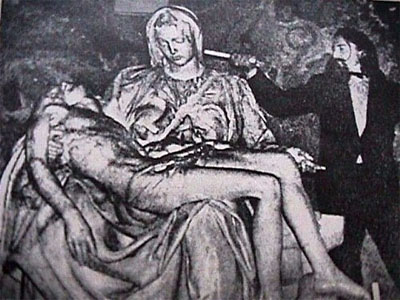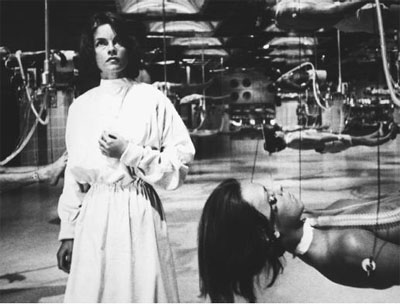No More Masterpieces
9 Sep 2009
Who was Laszlo Toth? Toth was the thirty-three-year-old Australian geologist of Hungarian birth who single-handedly hammered out the first principle of mail art: NO MORE MASTERPIECES. On May 21, 1972, Whitsunday (or Pentecost, the celebration of the descent of the Holy Ghost upon the apostles), at 11:30 a.m., as a crowd of worshippers and pilgrims waited to receive the Pope's blessing, Toth dashed past five black-uniformed guards, climbed over the marble balustrade in front of the Pieta in St. Peters, and gave Michelangelo's 473-year-old Virgin Mother (valued at $10 million) fifteen blows with a sledgehammer that had been concealed under his raincoat, all the while shouting "I am Jesus Christ! I am Jesus Christ!"

The Times ran a front-page photo of Toth (hammer in hand) astride the Virgin just one column over from Nixon and Kissinger chatting about peace in a Salzburg garden. The papers called Toth: Madman, Lunatic, Assassin, Fanatic, Vandal, Sociopath, Nihilist, and compared him to Manson, Oswald, Sirhan, Ray, and Bremer. The media concluded that the incident raised two important questions: Can the damage be repaired? and Where did protective measures fail?
Many art lovers had a difficult time controlling their grief. One art historian devoted an entire lecture to Pieta slides, but with the first picture both he and his students burst into tears. Meanwhile, back at St. Peters, a bullet-proof plexiglass screen was installed at the entrance to the chapel where the Pieta stood. Museums all over the world responded in horror and made expensive increases in security measures. The real issue raised by Toth's act of "cultural terrorism" was missed or covered up on the restoration: NO MORE MASTERPIECES.
Giacometti, the sculptor, once said that if he were caught in a burning house and could save only one thing, a priceless Rembrandt or a cat, he'd choose the cat. Toth's blows were gentle. They fell, after all, on stone, not flesh. This is more than can be said of Nixon and Kissinger, the war criminals whose gentlemanly chats have caused so much destruction and death in the world. Yet it was Toth, not them, who was arrested for his "crime." Roger Dunsmore, in his "improvisational text" entitled "Laszlo Toth" (from which I've lifted much of the above) asks, "Where are you, Laszlo Toth of the gentle hammer?"
One place to look for the spirit of Laszlo Toth is in mail art's insistence that there be no juried exhibitions: NO MASTERPIECES. Chuck Welch's "Open Letter Manifesto," in his book Networking Currents, looks at what is called "mail art" as a form of networking, and in this way seeks to take it out of any art-world context that might contaminate the process of creative communication and the spirit of community that underlies it. One shared way in which mail artists and other networkers interact with one another is through plagiarism. In 1988, we have seen mail artists participating in various "Festival of Plagiarism" events around the world. Given the elitism of the art world, plagiarism has a very negative connotation. Plagiarism as an art proclamation still shocks people in precisely the same way as Laszlo Toth's hammer. Both cry out NO MORE MASTERPIECES (itself an echo of Antonin Artaud's "original" statement to that effect of thirty years ago).
The ownership of ideas, as if they were material, is one of the pillars of Western Culture. Now, does the fact that the last sentence you just read was plagiarized word for word from L. Dunn in Photostatic Magazine rather than invented by me add or detract from the idea? Who can rightly claim ownership of an idea anyway? Perhaps if the sentence was plagiarized with the intent of deceiving the reader into thinking it was my words, or with a claim to the rewards of the literary marketplace for myself, the situation would be different. Instead, the sentence was plagiarized to call attention to plagiarism itself as a tool for subverting the commodified culture upon which Western "civilization" rests.
The negative connotation of plagiarism first gained currency in the Romantic era. The triumph of the bourgeoisie went hand in hand with the enshrinement of "Genius." In England it was the intellectual counterpoint of the movement of land enclosures. Both phenomena represent the extension of individual ownership into areas that had previously been considered inalienably collective and communal. The idea of the "original" is then directly linked to privilege. The original is viewed as superior to the copy, and, from this perspective, almost any hierarchy can be justified. (The ludicrousness of these assumptions was the subject of Alan Rudolph's film The Moderns.) In this context, the reason why the "restorers" of the Pieta are not looked down upon as plagiarists is that they are seen as preserving the material value of a unique work of art and thereby upholding the very idea of genius.

Today, with the advent of the photocopy machine, millions of people are participating in a mass, albeit relatively unorganized, movement to copy, rearrange, and paste using the ideas of others. In the world of sound reproduction, with the development of digital sampling techniques, plagiarism's collage possibilities are presently being explored not only by the "avant-garde" (John Oswald has coined the term "plunderphonics" to explain his use of audio piracy as a compositional prerogative at his Mystery Tape Laboratory), but in the realm of popular music as well (such as hip-hop anthems like the remix of "Paid in Full" by rappers Eric B. and Rakim). Given this situation, do we lament the collapse of the "avant garde" or encourage the spread of plagiarism?

This question implies reassessing plagiarism as a potential revolutionary force. The actions of the plagiarists subvert concepts of value based on labor time and the difficulty of production and, consequently, the political economic bedrock of capitalism. I wrote that last sentence but I borrowed it from Stewart Home, one of the organizers of this year's Festival of Plagiarism. For some, plagiarism as an artistic technique represents the "nothing left to say" cynicism of post-modernism. For others, plagiarism represents an attempt to expose and explode, once and for all, bourgeois individualism.
Plagiarism in this latter sense is a form of negation which involves re-inventing the language of those who would control us. By the creation of new meanings (detournement), plagiarism acts as the negation of a culture that finds its ideological justification in the "unique." In comparison, Postmodernist "appropriation" is very different from plagiarism. While post-modernist theory falsely asserts that there is no longer any basic reality, the plagiarist recognizes that Power is always a reality in historical society. By reconditioning dominant images through the conscious manipulation of pre-existing elements, by subjectivizing them, plagiarists aim to create a different reality than the media nightmare dictated by Power.
In this sense, the Artists' Strike, proposed by the Praxis Group, with its three years of inactivity (1990-1993) not only is an attack on the art-as-commodity notion of creativity, but can be seen symbolically as an attempt by artists to purge themselves of the capitalist value of "originality." Similarly, the uses of multiple names for serial use (e.g. Karen Eliot, Monty Cantsin) attacks the sacred cow of originality. Art, even much mail art, emphasizes the individuality of ownership and creation. Plagiarism and acts of "art vandalism" are only found shocking because "individual genius" is embedded deep in our consciousness as the ultimate justification of private property.
Plagiarism is Necessary. Progress Implies It. NO MORE MASTERPIECES!
[Originally published in The Cassette Mythos, Autonomedia 1990.]
◊